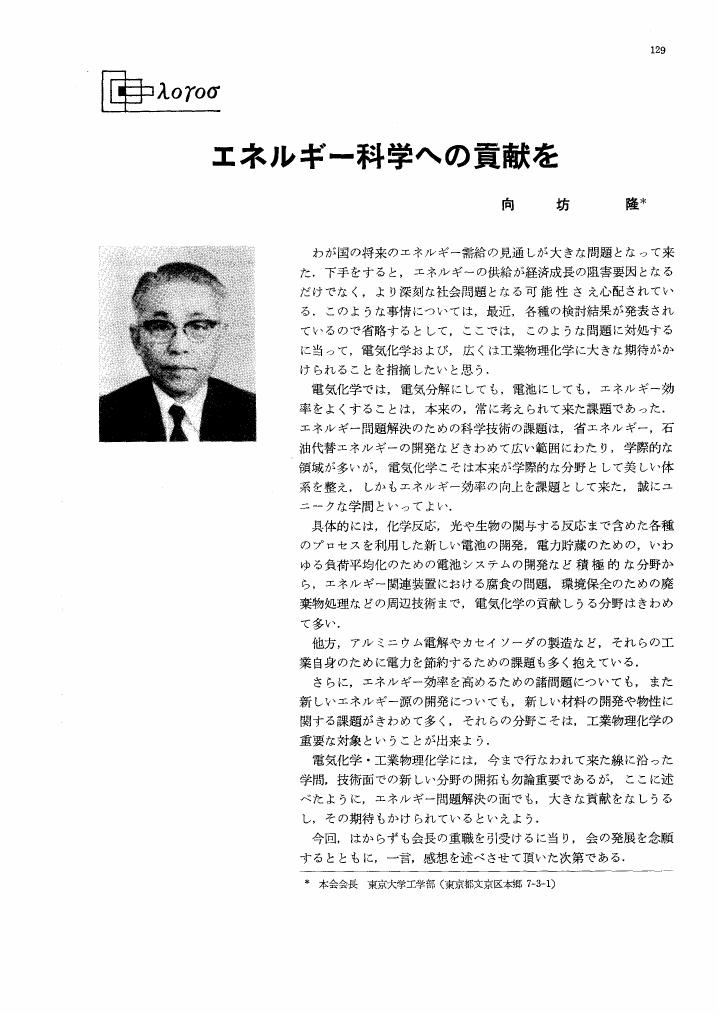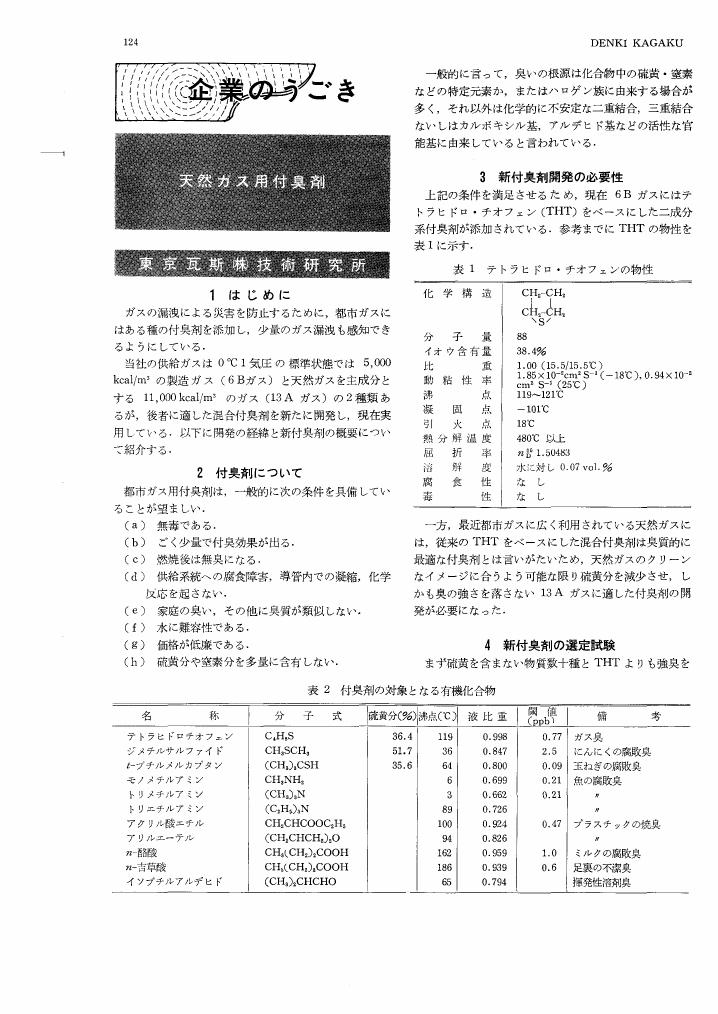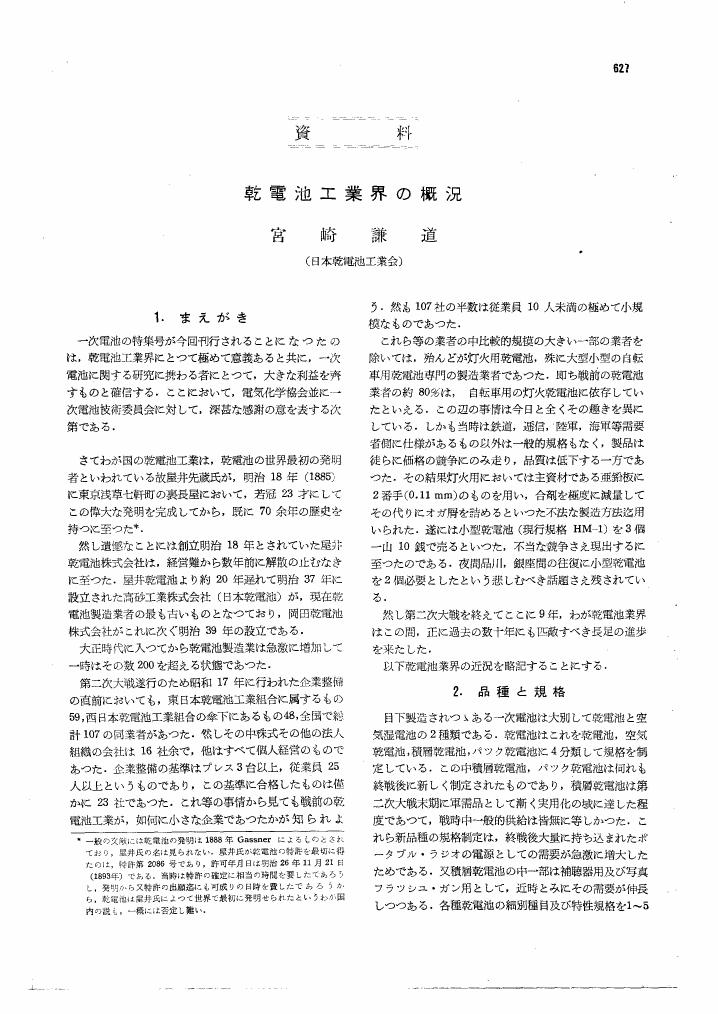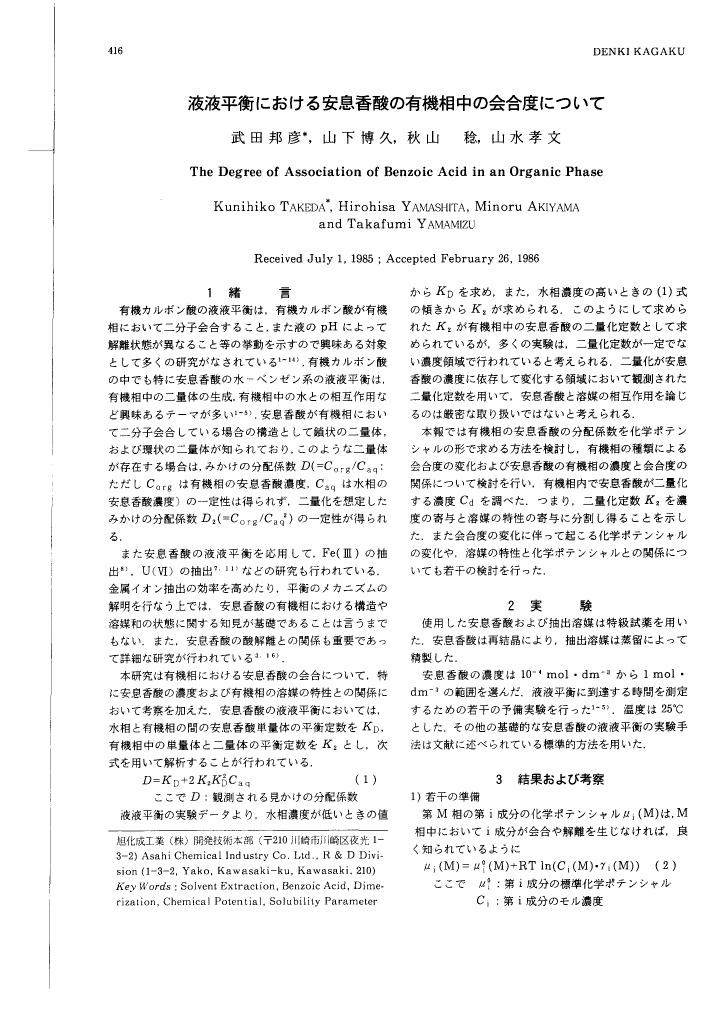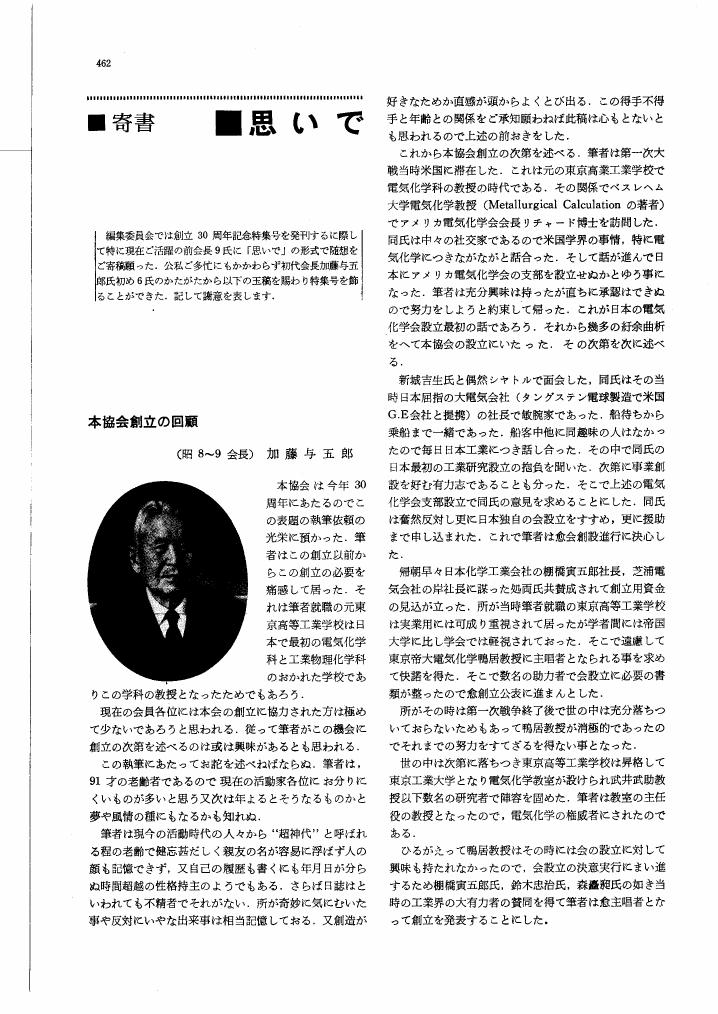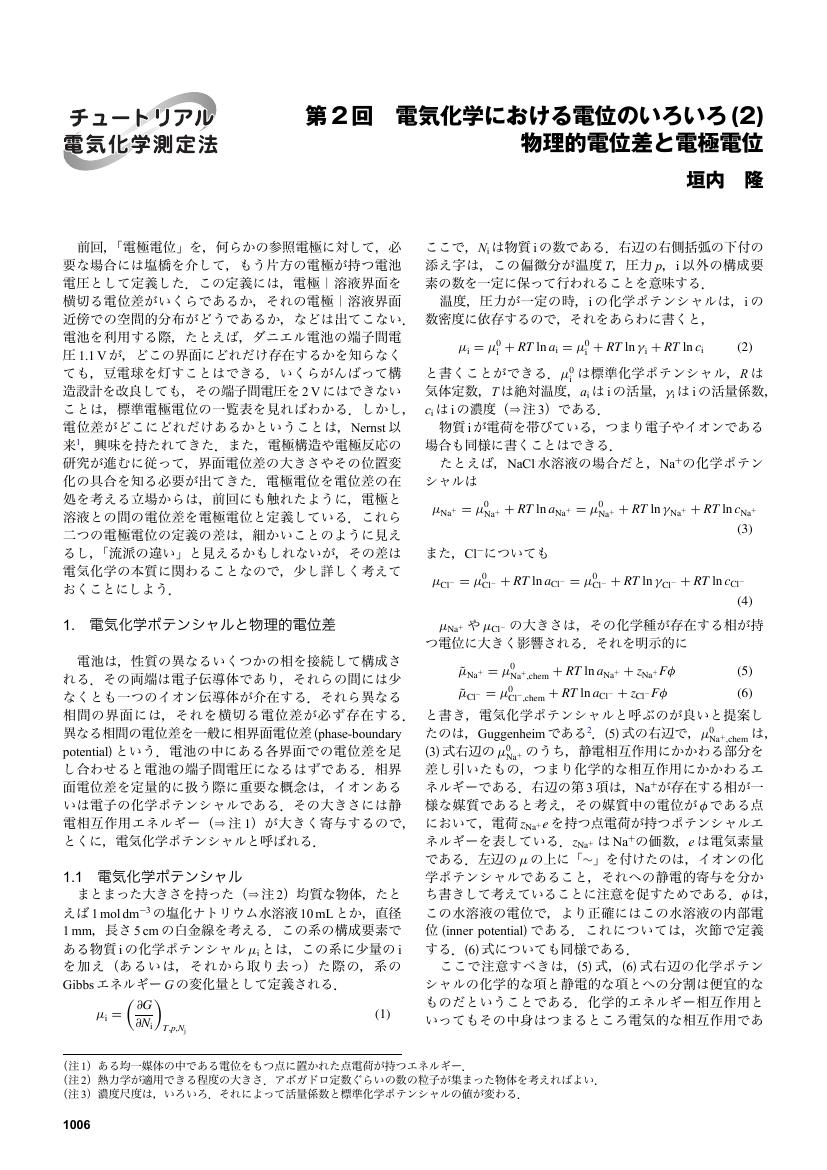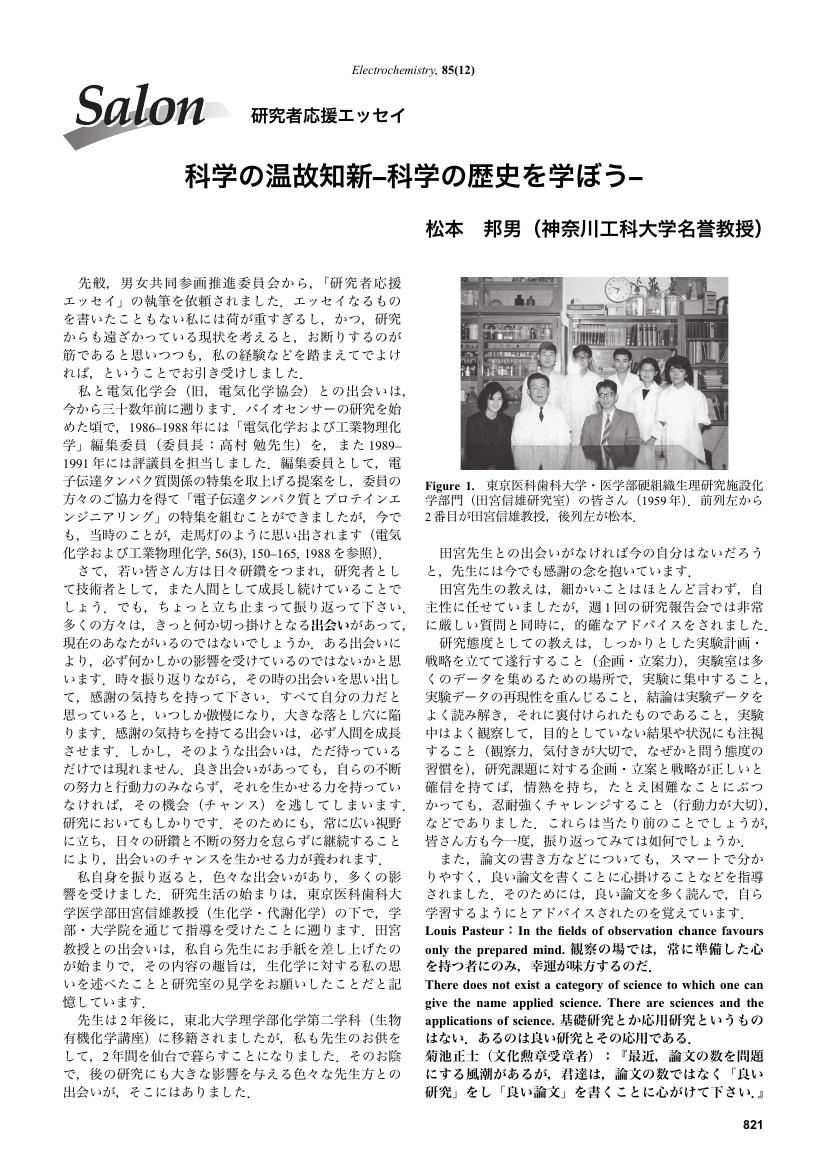1 0 0 0 OA 創造・発明への道
- 著者
- 山崎 貞一
- 出版者
- 公益社団法人 電気化学会
- 雑誌
- 電気化学および工業物理化学 (ISSN:03669297)
- 巻号頁・発行日
- vol.47, no.5, pp.273, 1979-05-05 (Released:2019-11-14)
1 0 0 0 OA エネルギー科学への貢献を
- 著者
- 向坊 隆
- 出版者
- 公益社団法人 電気化学会
- 雑誌
- 電気化学および工業物理化学 (ISSN:03669297)
- 巻号頁・発行日
- vol.45, no.3, pp.129, 1977-03-05 (Released:2019-11-15)
1 0 0 0 OA 電気化学協会略史
- 出版者
- 公益社団法人 電気化学会
- 雑誌
- 電氣化學 (ISSN:03669440)
- 巻号頁・発行日
- vol.21, no.7, pp.305-317, 1953-07-05 (Released:2019-11-30)
1 0 0 0 OA 昭和16年度通常総会に於ける会長挨拶
- 著者
- 鈴木 忠治
- 出版者
- 公益社団法人 電気化学会
- 雑誌
- 電氣化學 (ISSN:03669440)
- 巻号頁・発行日
- vol.9, no.6, pp.159-160, 1941-06-05 (Released:2019-11-30)
1 0 0 0 OA 天然ガス用付臭剤
- 著者
- 東京瓦斯(株)技術研究所
- 出版者
- 公益社団法人 電気化学会
- 雑誌
- 電気化学および工業物理化学 (ISSN:03669297)
- 巻号頁・発行日
- vol.47, no.2, pp.124-126, 1979-02-05 (Released:2019-11-14)
1 0 0 0 OA 乾電池工業界の概況
- 著者
- 宮崎 謙道
- 出版者
- 公益社団法人 電気化学会
- 雑誌
- 電氣化學 (ISSN:03669440)
- 巻号頁・発行日
- vol.22, no.11, pp.627-631, 1954-11-05 (Released:2019-11-15)
1 0 0 0 OA 液液平衡における安息香酸の有機相中の会合度について
- 著者
- 武田 邦彦 山下 博久 秋山 稔 山水 孝文
- 出版者
- 公益社団法人 電気化学会
- 雑誌
- 電気化学および工業物理化学 (ISSN:03669297)
- 巻号頁・発行日
- vol.54, no.5, pp.416-422, 1986-05-05 (Released:2019-09-30)
1 0 0 0 OA 黒鉛の電解酸化と消耗
- 著者
- 日根 文男 保田 昌樹
- 出版者
- 公益社団法人 電気化学会
- 雑誌
- 電気化学および工業物理化学 (ISSN:03669297)
- 巻号頁・発行日
- vol.39, no.6, pp.530-535, 1971-06-05 (Released:2019-11-18)
- 被引用文献数
- 1 1
1 0 0 0 OA リチウムイオン電池に用いるインターカレーション電極の相分離条件に関する熱力学的考察
- 著者
- 山木 準一 江頭 港 岡田 重人
- 出版者
- 公益社団法人 電気化学会
- 雑誌
- Electrochemistry (ISSN:13443542)
- 巻号頁・発行日
- vol.69, no.9, pp.664-669, 2001-09-05 (Released:2019-09-25)
- 参考文献数
- 9
- 被引用文献数
- 1
Lithium intercalation materials are widely used in lithium ion cells as cathode and anode active materials. Lithium intercalation materials show sometimes phase separation as a function of the amount of inserted Li+. The thermodynamic criterion of the phase separation of binary mixtures is already known using Gibbs free energy. The criterion of the phase separation was applied to that of lithium intercalation materials. We demonstrated the phase separation condition of the Li cathode for the cases of Gas Model and Coulomb Potential Model. By using Gas Model, the cathode potential is written as E = E0 + Ky + (RT/F) ln [(1−y)/y], where E is the cathode potential (V vs. Li), y is Li occupancy. In this case, two phase area is exp (−KF/2RT)<y<1−exp (−KF/2RT) and the potential is E0 + K/2. We have been considering the contribution of the internal energy change to the cell voltage (E vs. Li/Li+) assuming that the cathode material was completely ionic and only the Coulomb potential was effective in terms of changing the internal energy. From this model, we calculated E0 = 3.879 V and K = 1.020 V for LixNiO2 where y = 4 x (0<x<0.25). In this case, two phase area is 2.396 × 10−9 < y < 1 − 2.396 × 10−9 and the potential is 4.384 V.
1 0 0 0 OA 固体の放射線損傷
- 著者
- 吹田 徳雄 伊藤 憲昭
- 出版者
- 公益社団法人 電気化学会
- 雑誌
- 電氣化學 (ISSN:03669440)
- 巻号頁・発行日
- vol.28, no.4, pp.137-144, 1960-04-05 (Released:2019-09-11)
1 0 0 0 OA 腐食の歴史
- 著者
- 岡本 剛
- 出版者
- 公益社団法人 電気化学会
- 雑誌
- 電気化学および工業物理化学 (ISSN:03669297)
- 巻号頁・発行日
- vol.54, no.8, pp.671-674, 1986-08-05 (Released:2019-09-30)
- 著者
- 辻 流輝 Bogachuk Dmitry Luo Bin Haruyama Yuichi Niibe Masahito Mastroianni Simone Hinsch Andreas 伊藤 省吾
- 出版者
- 公益社団法人 電気化学会
- 雑誌
- 電気化学会第87回大会
- 巻号頁・発行日
- 2020-01-20
1 0 0 0 OA 自然が創造した分子工レク卜口ニクス素子―光合成系の分子構築と機能
- 著者
- 橋本 秀樹 柳 和宏
- 出版者
- 公益社団法人 電気化学会
- 雑誌
- Electrochemistry (ISSN:13443542)
- 巻号頁・発行日
- vol.71, no.11, pp.960-965, 2003-11-05 (Released:2019-08-30)
- 参考文献数
- 24
- 被引用文献数
- 1 1
1 0 0 0 5.アルミニウム金属負極を用いた二次電池
- 著者
- 津田 哲哉 桑畑 進
- 出版者
- 公益社団法人 電気化学会
- 雑誌
- 電気化学 (ISSN:24333255)
- 巻号頁・発行日
- vol.86, no.Winter, pp.305-310, 2018-12-05 (Released:2018-12-05)
- 参考文献数
- 43
1 0 0 0 OA MONOS不揮発性メモリ技術の開発
- 著者
- 南眞 一量 神垣 良昭
- 出版者
- 公益社団法人 電気化学会
- 雑誌
- Electrochemistry (ISSN:13443542)
- 巻号頁・発行日
- vol.72, no.7, pp.520, 2004-07-05 (Released:2019-06-08)
- 被引用文献数
- 1 1
1 0 0 0 OA 寄書-思い出
- 著者
- 加藤 與五郎 冨山 保 野村 與曽市 岡田 辰三 武井 武 石川 一郎
- 出版者
- 公益社団法人 電気化学会
- 雑誌
- 電気化学および工業物理化学 (ISSN:03669297)
- 巻号頁・発行日
- vol.31, no.7, pp.462-469, 1963-07-05 (Released:2019-10-15)
1 0 0 0 OA 電気化学協会とカーボン
- 著者
- 石川 敏功
- 出版者
- 公益社団法人 電気化学会
- 雑誌
- Electrochemistry (ISSN:13443542)
- 巻号頁・発行日
- vol.68, no.1, pp.46-47, 2000-01-05 (Released:2019-11-10)
1 0 0 0 OA 第2回 電気化学における電位のいろいろ(2) 物理的電位差と電極電位
- 著者
- 垣内 隆
- 出版者
- 公益社団法人 電気化学会
- 雑誌
- Electrochemistry (ISSN:13443542)
- 巻号頁・発行日
- vol.81, no.12, pp.1006-1011, 2013-12-05 (Released:2013-12-05)
- 参考文献数
- 14
- 被引用文献数
- 2 5
1 0 0 0 2.高濃度電解液の特異性に基づく二次電池革新の可能性
- 著者
- 山田 裕貴 山田 淳夫
- 出版者
- 公益社団法人 電気化学会
- 雑誌
- 電気化学および工業物理化学 (ISSN:13443542)
- 巻号頁・発行日
- vol.82, no.12, pp.1085-1090, 2014
- 被引用文献数
- 1
1 0 0 0 OA 科学の温故知新–科学の歴史を学ぼう–
- 著者
- 松本 邦男
- 出版者
- 公益社団法人 電気化学会
- 雑誌
- Electrochemistry (ISSN:13443542)
- 巻号頁・発行日
- vol.85, no.12, pp.821-822, 2017-12-05 (Released:2017-12-05)

